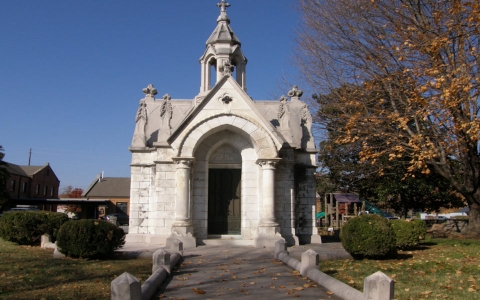What is it that attracts us to strange occurrences, things for which there is no explanation? Whatever the reason, most of us are drawn to a good mystery.
The odd historical events below range from incidents that could have been hoaxes to those caused by weather. They occurred in Alabama, Georgia, Louisiana, Mississippi and Tennessee.
What do you think? If you have comments or questions about these or other Southern mysteries, email kkazek@al.com.
1. The bleeding house of Atlanta, Ga.
Just before midnight on Sept. 8, 1987, an elderly couple discovered blood on floors and lower walls of the home they rented in Atlanta, Ga. Unable to find its source, 77-year-old Minnie Clyde Winston and 79-year-old William Winston contacted police. Blood was found on the bathroom floor and walls, in the kitchen, living room, hallways, bedroom, basement and crawl space.
The Winstons were the only occupants of the home and owned no pets. Police also found no source and took samples to be tested. The fluid was definitely blood, Type O. Minnie and William were both Type A.
Sgt. H.L. Bolton was quoted in the African American in October of 1987: “We have not stopped looking because we know houses don’t bleed,” he said. “But we haven’t determined that a crime was committed and that is our primary concern.”
No more blood was found and police eventually closed the investigation. The source of blood was never found.
2. The ghost ship of the Gloria Colita, Mobile, Ala.
On Jan. 21, 1940, a 125-foot British schooner called the Gloria Colita sailed from Mobile toward Cuba with a load of lumber. Less than two weeks later, on Feb. 4, theColita was discovered in the Gulf of Mexico, adrift and unmanned about 150 miles south of Mobile (some sources say she was found about 139 miles out).
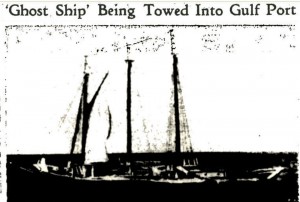
On Jan. 21, 1940, a 125-foot British schooner called the Gloria Colita, sailed from Mobile toward Cuba with a load of lumber. Less than two weeks later, on Feb. 4, the Colita was discovered in the Gulf of Mexico adrift and unmanned about 150 miles south of Mobile.
The Colita‘s rigging and rudder were gone and she was “badly damaged” overall., according to a Feb. 9, 1940, article in the Free Lance Star in Virginia. The Colitastarted out with a crew of nine seamen. “Apparently sudden winds striking before one of the sails could be lowered, washed the crew overboard,” the article said.
The Southeast Missourian published a Feb. 13 article that said: “Judging from wrecked remains of ship, old salts estimate that 100-foot waves broke over her, washing her crew overboard.” The Colita was towed to the Port of Mobile. Her crew was never seen again.
3. The phantom barber of Pascagoula, Miss.
Residents of Pascagoula, Miss., a bustling town besieged with new jobs as manufacture of warships increased, were on guard in June of 1942 after several people reported someone had stolen into their rooms at night to cut their hair.
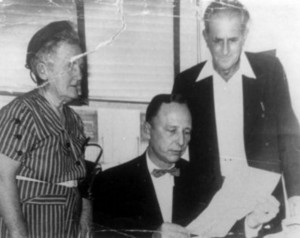
The police were baffled and residents were panicked by the mysterious intruder. After eight of the bizarre attacks, police got a break. Mr. and Mrs. Terrell Heidelberg were attacked in their home but this time rather than take hair, the intruder assaulted them, breaking Mrs. Heidelberg’s teeth and striking Mr. Heidelberg with an iron bar. As police searched for a suspect, one additional haircut attack occurred, according to oddlyhistorical.com. Then authorities announced the arrest of William A. Dolan – who had a grudge against Terrell’s father, a judge – was charged with attempted murder in the Heidelberg’s assault. Police also found a collection of human hair near his home and announced to the public the Phantom Barber had been captured. (Photo of William A. Dolan, the accused Phantom Barber, his wife Lucy and attorney Howard McDonnell, seated, in 1948. Contributed by Sandra Moncrieff via OddlyHistorical.com)
The stalker, soon nicknamed the Phantom Barber, first attacked on June 5, cutting the hair of two girls – Mary Evelyn Briggs and Edna Marie Hydel – at Our Lady of Victories Convent. According to a story on GulfLive.com, the girls said the man whispered “Shh” and left through a window. A few days later, he took the hair from a young girl in a private residence. He was partial to blonde-haired girls, sometimes taking a lock or two but other times taking nearly all the child’s hair. The police were baffled and residents were panicked by the mysterious intruder.
After eight of the bizarre attacks, police got a lead. Mr. and Mrs. Terrell Heidelberg were attacked in their home but this time rather than take hair, the intruder assaulted them, breaking Mrs. Heidelberg’s teeth and striking Mr. Heidelberg with an iron bar.
As police searched for a suspect, one additional haircut attack occurred, according tooddlyhistorical.com. Then authorities announced the arrest of William A. Dolan – who had a grudge against Terrell’s father, a judge – was charged with attempted murder in the Heidelbergs’ assault. Police also found a collection of human hair near his home and announced to the public the Phantom Barber had been captured.
However, Dolan was convicted only of the attack on the Heidelbergs and continued to deny he was the Phantom Barber.
Because the brutal attack of the Heidelbergs was so different from the Barber’s assaults and because Dolan was never charged with those crimes, people began to wonder if the Phantom Barber has eluded capture. The hair was never tested and the assaults stopped after Dolan’s arrest.
Was he the Phantom Barber? We will never know.
4. The blood-stained mausoleum of Cleveland, Tenn.
In the burial ground beside St. Luke’s Episcopal Church, one of Cleveland’s oldest landmarks, is a hauntingly beautiful white marble mausoleum built to hold the remains of a beloved 7-year-old girl.
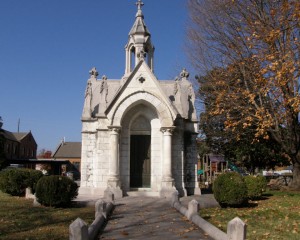
In the burial ground beside St. Luke’s Episcopal Church, one of Cleveland’s oldest landmarks, is a hauntingly beautiful white marble mausoleum built to hold the remains of a beloved 7-year-old girl. Nina Craigmiles was the daughter of two of Cleveland’s most prominent citizens, Adelia and John Henderson Craigmiles. On Oct. 18, 1871 – St. Luke’s Day – Nina was riding in a carriage with her grandfather, Dr. Gideon Thompson. For an unknown reason, the carriage was steered in front of an oncoming train; Nina was killed and Dr. Thompson was thrown clear. It is unclear who was driving the buggy. Thompson was known to let Nina take the reins at times. Nina’s family was devastated by her loss. John Craigmiles used his substantial fortune to create a lasting memorial: a stately church and beautiful mausoleum and tomb. No expense was spared. (Source: Roadrunner via RoadsideWonders.net)
Nina Craigmiles was the daughter of two of Cleveland’s most prominent citizens, Adelia and John Henderson Craigmiles. On Oct. 18, 1871 – St. Luke’s Day – Nina was riding in a carriage with her grandfather, Dr. Gideon Thompson. For an unknown reason, the carriage was steered in front of an oncoming train; Nina was killed and Dr. Thompson was thrown clear. It is unclear who was driving the buggy. Thompson was known to let Nina take the reins at times.
Nina’s family was devastated by her loss. John Craigmiles used his substantial fortune to create a lasting memorial: a stately church and beautiful mausoleum and tomb. No expense was spared.
According to the website for St. Luke’s Episcopal Church, Craigmiles asked it be named for the day on which Nina was killed. “The building was consecrated on St. Luke’s Day in 1872, the anniversary of Nina’s death,” the website says.
The Craigmiles mausoleum is made of Carrara marble from Italy. It features 4-foot thick walls and is topped with a marble spire and cross. Inside, Nina was interred in a marble sarcophagus that is inscribed: “Born August 5, 1864. Nina, daughter of M. Adelia and John H.E. Craigmiles. Fell asleep October 18, 1871.”
Other family members, including Nina’s parents, were interred upon their deaths. In his will, John Craigmiles had stipulated: “I wish to very plainly be buried in the lower-hand catacomb in the vault or mausoleum where sleeps the ashes of our darling little Nina.”
The mystery surrounding Nina’s tragic death began after she was interred. All accounts from the time state that the marble used for the mausoleum was white when it was built. After all, John Craigmiles would have accepted nothing but perfection for his daughter. Yet, when she was placed inside, spots of red appeared above the mausoleum entrance. Efforts to clean the spots were unsuccessful.
There’s no disputing the red streaks appeared on the marble and that people have attempted to clean it to no avail. However, other details reported are based on legend and not fact: Many people say the red marks deepened in hue each time another family member was interred and surely represent blood; others claim the stained marble blocks were replaced but the stains returned.
How the red marks got there remains a mystery.
5. The phantom whistler of Paradis, La.
In September 1950, newspapers around the country detailed the case of a mysterious whistler who stalked a young woman from Paradis, La. Eighteen-year-old Jacquelyn Cadow told authorities the incidents began in February when someone started making wolf whistles beneath the bedroom window of the home she shared with her mother. Cadow also said someone had broken into the house. Police could find no signs of the whistler.
Soon, Cadow announced her engagement to a local state trooper, Herbert Belsom. The Phantom Whistler still came, but he had changed his tune to a “warbling funeral march,” according to an article in the St. Petersburg Times. Cadow also began receiving threatening phone calls.
The Reading Eagle in Pennsylvania reported on Sept 21, 1950: “For the past few days the townspeople have talked of little except the intruder who threatened the girl’s life and vowed to prevent her marriage to a young state trooper. Opinion is divided over whether the nocturnal whistler is a prankster, a would-be killer or a lunatic.”
Deputies began guarding the Cadow home at night. Neighbors and reporters began coming to the house in an attempt to catch a glimpse of the Phantom.
At one point, Cadow, her mother, aunt and a reporter from the New Orleans States-Item all heard the Whistler but no one was found. Cadow tried staying with relatives but the Whistler followed her and continued his harassment. The nerves of the young bride-to-be were frayed and she nearly suffered a breakdown.
Finally on Oct. 1, Cadow and Belsom were married without incident. The Whistler was never heard again and the sheriff pronounced the case closed.
The Whistler’s identity was never determined.
6. The voodoo hex of Shelbyville, Tenn.
This tale involves a 1957 murder that was quickly solved. The mystery surrounding the incident lies in its purported supernatural elements. On March 22, 1957, the bullet-ridden body of Simon Warner, a self-described “crime doctor” and owner of the Country Café.
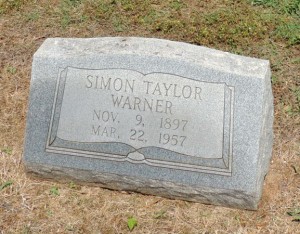
This tale involves a 1957 murder that was quickly solved. The mystery surrounding the incident lies in its purported supernatural elements. On March 22, 1957, the bullet-ridden body of Simon Warner, a self-described “crime doctor” and owner of the Country Cafe. Police soon arrested Mose H. Martin of Stevenson, Ala., and charged him with first-degree murder. Martin said he had consulted Warner, who was
Police soon arrested Mose H. Martin of Stevenson, Ala., and charged him with first-degree murder. Martin said he had consulted Warner, who was known locally for his psychic abilities and often told fortunes.
Warner took pride in helping solve, or even prevent, crimes. A March 23, 1957, article in the Gadsden Times reported: “Warner had said on previous occasions he was able to see a killing shaping up months in advance and ‘I always do all I can to keep it from happening.'”
People came from miles around to have their fortunes told by Martin and many claimed his powers were astonishing. However, in the case of Mose Martin, something went wrong. Martin told authorities he had paid Warner $50 to cure a stomach ailment. Officer Durwood Thompson quoted Martin as saying: “I shot him because he double-crossed me in voodoo. I would have shot anybody who double-crossed me in black magic like he did.”
Turns out, Martin’s stomach ailment had grown worse after Warner’s treatment, which was never revealed, leaving Martin convinced he had been the victim of a “voodoo hex.” In the end, Warner could not predict his own murder; at least not in time to stop it.
7. The day it rained eels in Coalburg, AL
In May of 1892, the New York Sun reported a strange event following a storm in the tiny community of Coalburg, Ala.: It was raining eels. And not just any eels, but a type “unknown in Alabama,” according to “The Book of the Damned: The Collected Works of Charles Fort” published in 1919.
Fort wrote: “Piles of them in the streets – people alarmed – farmers coming with carts and taking them away for fertilizing material.” An article in The Scientific American Presents in 2000, titled “It’s Raining Eels: A Compendium of Weird Weather,” said the eels had likely been sucked up by the storm.
“The eel deluge may have resulted from a waterspout lifting and jettisoning the fishes,” the article said. But to this day, no one knows where the eels began their journey and how they ended up in Alabama.
Other incidences of animal rains have been recorded, most commonly fish. Eels also fell on Natchez, Miss., in April 1921.
Fish fell over Marksville, La., on Oct. 23, 1947. The skies were foggy but no storms were reported. The fish included large-mouth black bass, sunfish, goggle-eye and hickory shad.
On a clear day in May 1956, fish fell on Chilatchee, Ala. Reportedly the “fish rain” that included catfish, perch and bream lasted for about 15 minutes.
Odd South is a regional version of Kelly Kazek’s Odd Travels through Alabama. Join her on her weekly journey through the South to record the region’s quirky history, strange roadside attractions and tales of colorful characters. Find her on Facebookor follow her Odd Travels and Real Alabama boards on Pinterest. al.com.

